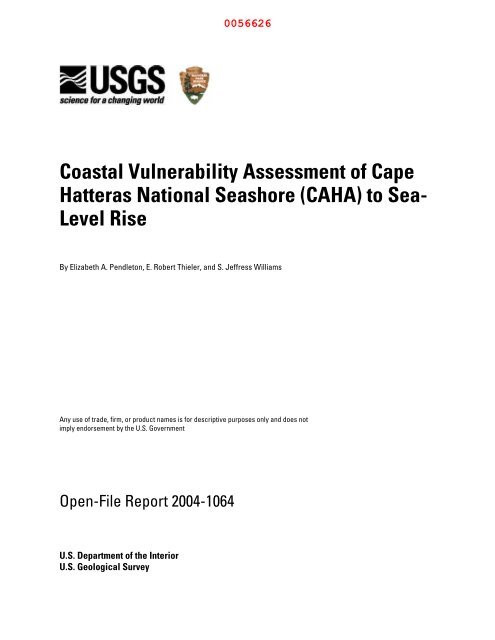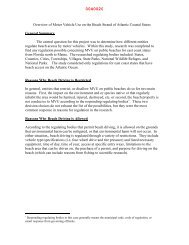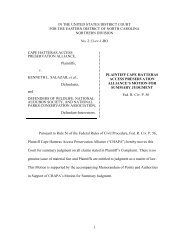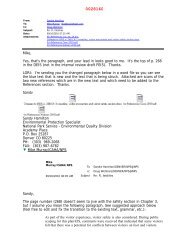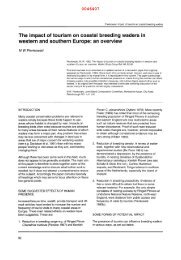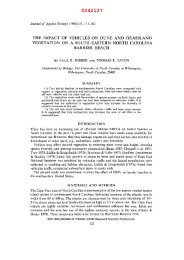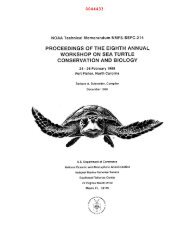Level Rise - Outer Banks Preservation Association
Level Rise - Outer Banks Preservation Association
Level Rise - Outer Banks Preservation Association
You also want an ePaper? Increase the reach of your titles
YUMPU automatically turns print PDFs into web optimized ePapers that Google loves.
0056626Coastal Vulnerability Assessment of CapeHatteras National Seashore (CAHA) to Sea-<strong>Level</strong> <strong>Rise</strong>By Elizabeth A. Pendleton, E. Robert Thieler, and S. Jeffress WilliamsAny use of trade, firm, or product names is for descriptive purposes only and does notimply endorsement by the U.S. GovernmentOpen-File Report 2004-1064U.S. Department of the InteriorU.S. Geological Survey
0056627U.S. Department of the InteriorGale A. Norton, SecretaryU.S. Geological SurveyCharles G. Groat, DirectorU.S. Geological Survey, Reston, Virginia 2004-1064For Additional Information:See the National Park Unit Coastal Vulnerability study at http://woodshole.er.usgs.gov/project-pages/nps-cvi/,the National Coastal Vulnerability study at http://woodshole.er.usgs.gov/project-pages/cvi/,or view the USGS online fact sheet for this project in PDF format at http://pubs.usgs.gov/fs/fs095-02/.To visit Cape Hatteras National Seashore go to http://www.nps.gov/caha/index.htm .Contact:Elizabeth A. Pendleton, E. Robert Thieler, S. Jeffress WilliamsU.S. Geological Survey384 Woods Hole RoadWoods Hole, MA 02543ependleton@usgs.gov, rthieler@usgs.gov,jwilliams@usgs.govTelephone: 508-457-2259 or 508-548-8700Rebecca BeaversNational Park ServiceNatural Resource Program CenterGeologic Resources DivisionP.O. Box 25287Denver, CO 80225-0287Rebecca_Beavers@nps.govTelephone: 303-987-6945For product and ordering information:World Wide Web: http://www.usgs.gov/pubprodTelephone: 1-888-ASK-USGSFor more information on the USGS—the Federal source for science about the Earth,its natural and living resources, natural hazards, and the environment:World Wide Web: http://www.usgs.govTelephone: 1-888-ASK-USGSAlthough this report is in the public domain, permission must be secured from the individualcopyright owners to reproduce any copyrighted material contained within this report.
0056628ContentsAbstract .........................................................................................................................................................................2Introduction ...................................................................................................................................................................2Data Ranking.................................................................................................................................................................3Cape Hatteras National Seashore...................................................................................................................................3Methodology..................................................................................................................................................................4Geologic Variables ........................................................................................................................................................4Physical Process Variables ............................................................................................................................................5Coastal Vulnerability Index...........................................................................................................................................5Results ...........................................................................................................................................................................6Discussion......................................................................................................................................................................6Conclusions ...................................................................................................................................................................7References .....................................................................................................................................................................7List of Figures and Tables .............................................................................................................................................9
0056629Coastal Vulnerability Assessment of CapeHatteras National Seashore (CAHA) to Sea-<strong>Level</strong> <strong>Rise</strong>By Elizabeth A. Pendleton, E. Robert Thieler, S. and Jeffress WilliamsAbstractA coastal vulnerability index (CVI) was used to map the relative vulnerability of the coast to future sealevelrise within Cape Hatteras National Seashore (CAHA) in North Carolina. The CVI ranks the following in termsof their physical contribution to sea-level rise-related coastal change: geomorphology, regional coastal slope, rate ofrelative sea-level rise, historical shoreline change rates, mean tidal range, and mean significant wave height. Therankings for each variable were combined and an index value was calculated for 1-minute grid cells covering thepark. The CVI highlights those regions where the physical effects of sea-level rise might be the greatest. Thisapproach combines the coastal system's susceptibility to change with its natural ability to adapt to changingenvironmental conditions, yielding a quantitative, although relative, measure of the park's natural vulnerability to theeffects of sea-level rise. The CVI provides an objective technique for evaluation and long-term planning byscientists and park managers. Cape Hatteras National Seashore consists of stable and washover dominated segmentsof barrier beach backed by wetland and marsh. The areas within Cape Hatteras that are likely to be most vulnerableto sea-level rise are those with the highest occurrence of overwash and the highest rates of shoreline change.IntroductionThe National Park Service (NPS) is responsible for managing nearly 12,000 km (7,500 miles) of shorelinealong oceans and lakes. In 2001, the U.S. Geological Survey (USGS), in partnership with the NPS GeologicResources Division, began conducting hazard assessments of future sea-level change by creating maps to assist NPSin managing its valuable coastal resources. This report presents the results of a vulnerability assessment for CapeHatteras National Seashore (CAHA), highlighting areas that are likely to be most affected by future sea-level rise.Global sea level has risen approximately 18 centimeters (7.1 inches) in the past century (Douglas, 1997).Climate models predict an additional rise of 48 cm (18.9 in.) by 2100 (IPCC, 2001), which is more than double therate of rise for the 20th century. Potential coastal impacts of sea-level rise include shoreline erosion, saltwaterintrusion into groundwater aquifers, inundation of wetlands and estuaries, and threats to cultural and historicresources as well as infrastructure. Predicted accelerated global sea-level rise has generated a need in coastalgeology to determine the response of a coastline to sea-level rise. However, an accurate and quantitative approach topredicting coastal change is difficult to establish. Even the kinds of data necessary to make shoreline responsepredictions are the subject of scientific debate. A number of predictive approaches have been proposed (NationalResearch Council, 1990), including: 1) extrapolation of historical data (e.g., coastal erosion rates), 2) staticinundation modeling, 3) application of a simple geometric model (e.g., the Bruun Rule), 4) application of a sedimentdynamics/budget model, or 5) Monte Carlo (probabilistic) simulation based on parameterized physical forcingvariables. However, each of these approaches has inadequacies or can be invalid for certain applications (NationalResearch Council, 1990; 1995). Additionally, shoreline response to sea-level change is further complicated byhuman modifications of the natural coast such as beach nourishment projects, and engineered structures such asseawalls, revetments, groins, and jetties. Understanding how a natural or modified coast will respond to sea-levelchange is essential to preserving vulnerable coastal resources.The primary challenge in predicting shoreline response to sea-level rise is identifying and quantifying theimportant variables that contribute to coastal evolution in a given area. In order to address the multi-faceted task ofpredicting sea-level rise impact, the USGS has implemented a methodology to identify areas that may be most2
0056630vulnerable to impacts of future sea-level rise (see Hammar-Klose and Thieler, 2001). This approach combines thecoastal system's susceptibility to change with its natural ability to adapt to changing environmental conditions,yielding a quantitative, although relative, measure of the shoreline's natural vulnerability to the effects of sea-levelrise. The methodology focuses on six variables which strongly influence coastal evolution:1) Geomorphology2) Historical shoreline change rate3) Regional coastal slope4) Relative sea-level change5) Mean significant wave height6) Mean tidal rangeThese variables can be divided into two groups: 1) geologic variables and 2) physical process variables.The geologic variables are geomorphology, historic shoreline change rate, and coastal slope; they account for ashoreline's relative resistance to erosion, long-term erosion/accretion trend, and its susceptibility to flooding,respectively. The physical process variables include sea-level change, significant wave height, and tidal range, all ofwhich contribute to the inundation hazards of a particular section of coastline over time scales from hours tocenturies. A relatively simple vulnerability ranking system (Table 1) allows the six variables to be incorporated intoan equation that produces a coastal vulnerability index (CVI). The CVI can be used by scientists and park managersto evaluate the likelihood that physical change may occur along a particular shoreline as sea level continues to rise.Additionally, NPS staff will be able to incorporate information provided by this vulnerability assessment techniqueinto general management plans.Data RankingTable 1 shows the six variables described in the Introduction, which include both quantitative andqualitative information. Numeric variable values are assigned a vulnerability ranking based on value ranges,whereas the non-numerical geomorphology variable is ranked qualitatively according to the relative resistance of agiven landform to erosion. Shorelines with historical erosion/accretion rates between -1.0 and +1.0 m/yr are rankedas moderate. Increasingly higher erosion or accretion rates are ranked as correspondingly higher or lowervulnerability. Regional coastal slopes range from very high risk, 1.2percent. The rate of relative sea-level change is ranked using the modern rate of eustatic rise (1.8 mm/yr) as verylow vulnerability. Since this is a global or "background" rate common to all shorelines, the sea-level rise rankingreflects primarily local to regional isostatic or tectonic adjustment. Mean wave height rankings range from very low(1.25 m). Tidal range is ranked such that microtidal (6 m) coasts are very low vulnerability.Cape Hatteras National SeashoreCape Hatteras National Seashore is part of the <strong>Outer</strong> <strong>Banks</strong> of North Carolina, which stretch more than 280kilometers (175 miles) from Virginia to Shackleford <strong>Banks</strong>, along the Atlantic coast of North Carolina (Figure 1).The National Seashore extends 115 km (70 mi) over portions of three barriers islands, Bodie, Hatteras, andOcracoke. These narrow barriers are separated from the North Carolina mainland by wide, shallow Pamlico Sound.Most of the barriers within the National Seashore are only a few hundred (
0056631shipwrecks have occurred along the North Carolina coast since the 1600s (for more information seehttp://coastalguide.com/packet/shipwrecks01.htm or http://www.nps.gov/caha/shipwreck.htm).Storm impacts on coastal evolution along the <strong>Outer</strong> <strong>Banks</strong> are too numerous to detail here, but for acomprehensive overview of storms and storm tracks along the coast of North Carolina since 1933 see:http://www.erh.noaa.gov/er/akq/hist.htm. Also a summary of the recent impacts of Hurricane Isabel (September2003) is hosted by USGS at: http://coastal.er.usgs.gov/hurricanes/Isabel/.Six locations in and around the national seashore have been identified by the <strong>Outer</strong> <strong>Banks</strong> Task Force( http://www.obtf.org/ ) as erosional hot spots, or sections of coast where the dunes are frequently destroyed bystorms. Sections of North Carolina highway 12 have been relocated in these hot spot areas, and when breaks form inthe dunes they are immediately filled, which may interfere with natural barrier overwash processes. Some scientistssuggest that storms and overwash processes are essential to the evolution of these barriers, and human interferencethrough dune building, road maintenance, and breach filling only ensures an increase in vulnerability of theseislands (Dolan and Lins, 1986; Pilkey and others, 1998). Park managers, charged with resource preservation forfuture generations, are faced with a difficult task along the <strong>Outer</strong> <strong>Banks</strong>.This report does not directly address the vulnerability of the bay side shoreline of Cape Hatteras NationalSeashore to future sea-level rise, because the methodology presented here does not apply well to quieter water orestuarine wetland environments; however, the authors acknowledge the important issues impacting the Pamlico andAlbemarle Sound shoreline and direct interested readers to investigations on sea-level rise and estuarine shorelineerosion along the North Carolina Coast produced by Riggs (2001) and Riggs and Ames (2003).MethodologyIn order to develop a database for a park-wide assessment of coastal vulnerability, data for each of the sixvariables mentioned above were gathered from state and federal agencies (Table 2). The database is based on thatused by Thieler and Hammar-Klose (1999) and loosely follows an earlier database developed by Gornitz and White(1992). A comparable assessment of the sensitivity of the Canadian coast to sea-level rise is presented by Shaw andothers (1998). The database was constructed using a 1:70,000-scale shoreline for Cape Hatteras that was producedfrom the medium resolution digital vector U.S. shoreline provided by the Strategic Environmental AssessmentsDivision of the National Oceanic and Atmospheric Administration's Office of Ocean Resources Conservation andAssessment (http://spo.nos.noaa.gov/projects/shoreline/shoreline.html). Data for each of the six variables(geomorphology, shoreline change, coastal slope, relative sea-level rise, significant wave height, and tidal range)were added to the shoreline attribute table using a 1-minute (approximately 1.5 km) grid (Figure 2). Next eachvariable in each grid cell were assigned a relative vulnerability value from 1-5 (1 is very low vulnerability, 5 is veryhigh vulnerability) based on the potential magnitude of its contribution to physical changes on the coast as sea levelrises (Table 1).Geologic VariablesThe geomorphology variable expresses the relative erodibility of different landform types (Table1). Thesedata were derived from 1998 1-meter resolution digital aerial orthophotographs of Cape Hatteras (Tabale 2). Inaddition, field visits were made within the park to ground-truth the geomorphologic classifications. Thegeomorphology of Cape Hatteras varies from high vulnerability barrier island with dunes to very high vulnerabilitywashover-dominated barrier shoreline (Figure 3-10). A Hurricane Isabel impact study shows the barrier breach thatformed between Frisco and Hatteras Village on September 18, 2003 (Figure 11) (USGS, 2003). This breachoccurred in a washover-dominated very high vulnerability area. The U.S. Army Corps of Engineers and the NCDOTclosed the inlet and reconstructed Highway 12 during October and November of 2003.Shoreline erosion and accretion rates for Cape Hatteras were calculated from existing shoreline dataprovided by USGS (Table 2). Shoreline rates of change (m/yr) were calculated at 200 m intervals (transects) alongthe coast using Digital Shoreline Analysis System software to derive the rate of shoreline change over time (Thieler4
0056632and others, 2003). The rates for each transect within a 1-minute grid cell were averaged to determine the shorelinechange value used here, with positive numbers indicating accretion and negative numbers indicating erosion.Shoreline change rates on Cape Hatteras range from greater than 2 m/yr of accretion (very low vulnerability ) togreater than 2 m/yr of erosion (very high vulnerability) (Figure 12 A-D).The determination of regional coastal slope identifies the relative vulnerability of inundation and thepotential rapidity of shoreline retreat because low-sloping coastal regions should retreat faster than steeper regions(Pilkey and Davis, 1987). The regional slope of the coastal zone was calculated from a grid of topographic andbathymetric elevations extending 10 km landward and seaward of the present-day shoreline. Elevation data wereobtained from the National Geophysical Data Center (NGDC) as gridded topographic and bathymetric elevations at0.1 meter vertical resolution for 3 arc-second (~90 m) grid cells (Table 2). Regional coastal slopes for Cape Hatterasfall within the high vulnerability (4) to very high vulnerability (5) category (Table 1).Physical Process VariablesThe relative sea-level change variable is derived from the increase or decrease in annual mean waterelevation over time as measured at tide gage stations along the coast. The rate of sea-level rise in Beaufort, NC(about 75 km SW of Ocracoke Island) is 3.71 +/- 0.64 mm/yr based on 27 years of data (Zervas, 2001) (Table 2).This variable inherently includes both global sea-level rise as well as regional sea-level rise due to isostatic andtectonic adjustments of the land surface. Relative sea-level change data are a historical record, and thus only portraythe recent sea-level trend (
0056633where, a = geomorphology, b = shoreline erosion/accretion rate, c = coastal slope, d =relative sea-level riserate, e = mean significant wave height, and f = mean tide range. The calculated CVI value is then divided intoquartile ranges to highlight different vulnerabilities within the park. The numeric CVI values that correspond to aspecific vulnerability index (low - very high) are unique to Cape Hatteras National Seashore, and are not comparableto CVI ranges in other parks where the CVI has been employed (i.e., very high vulnerability means the same amongparks; it's the numeric values that differ, such that a numeric value that equals very high vulnerability in one parkmay equal moderate vulnerability in another). To compare vulnerability among coastal parks, the national-scalestudies should be used (Thieler and Hammar-Klose, 1999, 2000a, and 2000b). This approach best describes andhighlights the vulnerability specific to each park.ResultsThe calculated CVI values for Cape Hatteras range from 18.26 to 51.03. The mean CVI value is 37.64; themode is 45.64 and the median 36.5. The standard deviation is 7.5. The 25th, 50th, and 75th percentiles are 32.0,36.0, and 42.0, respectively.Figure 14 shows a map of the CVI (vulnerability ranges) for Cape Hatteras National Seashore. The CVI scores aredivided into low, moderate, high, and very high-vulnerability categories based on the quartile ranges and visualinspection of the data. CVI values below 32.0 are assigned to the low vulnerability category. Values from 32.0-36.0are considered moderate vulnerability. High-vulnerability values lie between 36.01 and 42.0.CVI values above 42.0 are classified as very high vulnerability. Figure 14 shows a histogram of thepercentage of CAHA shoreline in each vulnerability category. Nearly 195 km (120 miles) of shoreline is evaluatedalong the <strong>Outer</strong> <strong>Banks</strong>. Of this total, 27 percent of the mapped shoreline is classified as being at very highvulnerability due to future sea-level rise. Another 27 percent is classified as high vulnerability, 30 percent asmoderate vulnerability, and sixteen percent as low vulnerability.DiscussionThe data within the CVI show variability at different spatial scales (Figure 13). However, the ranked valuesfor the physical process variables vary little over the extent of the shoreline. The value of the relative sea-level risevariable is constant at very high vulnerability for the entire study area. The significant wave height vulnerability isvery high to high, and the tidal range is very high vulnerability.The geologic variables show greater variability and thus have the most influence on the CVI value andranges (Figure 13). Geomorphology in the park includes high vulnerability barrier island shoreline with dune ridgesseparated by very high vulnerability washover-dominated low areas. Vulnerability assessment based on historicalshoreline change trends varies from very low to very high (Figure 12 A -D). Regional coastal slope is mostly in thevery high vulnerability range with a few high vulnerability slope areas.The most influential variables in the CVI are geomorphology, shoreline change, regional coastal slope andsignificant wave height; therefore they may be considered the dominant factors controlling how Cape Hatteras willevolve as sea level rises. Geomorphology, coastal slope, and significant wave height only vary between high andvery high vulnerability, whereas shoreline change ranges from very low to very high.Because of the importance of habitat and the dynamic nature of the <strong>Outer</strong> <strong>Banks</strong>, concern about erosion,storm surge breaching of the barriers, future sea-level rise, and mainland flooding, planning is underway by private,federal, and state agencies to address these issues. Alternatives such as large-scale nourishment of the beach anddunes along Cape Hatteras are being considered. Implementation of future beach nourishment could alter the CVIresults presented here.6
0056634ConclusionsThe coastal vulnerability index (CVI) provides insight into the relative potential of coastal change due tofuture sea-level rise. The maps and data presented here can be viewed in at least two ways:1) as an example of where physical changes are most likely to occur as sea-level rises; and2) as a planning tool for the Cape Hatteras National Seashore.As ranked in this study, geomorphology, shoreline change, coastal slope, and significant wave height arethe most important variables in determining the CVI for Cape Hatteras National Seashore. Tide range and sea-levelrise do not contribute to the spatial variability in the CVI.Cape Hatteras National Seashore preserves a dynamic natural environment, which must be understood inorder to be managed properly. The CVI is one way that a park can assess objectively the natural factors thatcontribute to the evolution of the coastal zone, and thus how the park may evolve in the future.ReferencesDolan, R., and Lins, H., 1986, The <strong>Outer</strong> <strong>Banks</strong> of North Carolina: U.S. Geological Survey Professional Paper, Report 1177-B, 47 p.Douglas, B.C., 1997, Global sea rise, a redetermination: Surveys in Geophysics, v. 18, p. 279-292.Gornitz, V., and White, T.W., 1992, A coastal hazards database for the U.S. West Coast: ORNL/CDIAC-81, NDP-043C, Oak RidgeNational Laboratory, Oak Ridge, Tenn.Gornitz, V.M., Daniels, R.C., White, T.W., and Birdwell, K.R., 1994, The development of a coastal vulnerability assessment database,Vulnerability to sea-level rise in the U.S. southeast: Journal of Coastal Research, Special Issue No. 12, p. 327-338.Hammar-Klose, E.S., and Thieler, E.R., 2001, Coastal vulnerability to sea level rise--A preliminary database for the U.S. Atlantic,Pacific, and Gulf of Mexico coasts: U.S. Geological Survey Digital Data Series - 68, CD-ROM. (Available online at:http://pubs.usgs.gov/dds/dds68/.)Hubertz, J.M., Thompson, E.F., and Wang, H.V., 1996, Wave Information Studies of U.S. coastlines, Annotated bibliography oncoastal and ocean data assimilation: WIS Report 36, U.S. Army Engineer Waterways Experiment Station, Vicksburg, 31p.IPCC (Intergovernmental Panel on Climate Change), 2001, Climate Change 2001, in Houghton, J.T., Ding, Y., Griggs, D.J., Noguer,M., van der Linden, P.J., and Xiaosu, D., eds., The Scientific Basis; Contribution of Working Group I to the ThirdAssessment Report of the Intergovernmental Panel on Climate Change (IPCC): Cambridge, University Press, U.K., 944 p.(Also available at http://www.ipcc.ch/)National Research Council, 1990, Managing Coastal Erosion, Washington: National Academy Press, 163 p.National Research Council, 1995, Beach Nourishment and Protection, Washington: National Academy Press, 334 p.Pilkey, O.H., and Davis, T.W., 1987, An analysis of coastal recession models, North Carolina coast, in D. Nummedal, O.H. Pilkey andJ.D. Howard, eds., Sea-level Fluctuation and Coastal Evolution: SEPM (Society for Sedimentary Geology) SpecialPublications No. 41, Tulsa, Okla., p. 59-68.Pilkey, O.H., Neal, W.J., Riggs, S.R., Webb, C.A., Bush, D.M., Pilkey, D.F., Bullock, J., and Cowan, B.A., 1998, The North CarolinaShore and Its Barriers: Restless Ribbons of Sand: Duke University Press, Durham, N.C., 318 p.7
0056635Riggs, S.R., 2001, Shoreline erosion in North Carolina estuaries: The soundfront series UNC-SG-01-11, North Carolina Seagrant,Raleigh, N.C., 68 p.Riggs, S.R., and Ames, D.V., 2003, Drowning the North Carolina Coast; sea-level rise and estuarine dynamics: UNC-SG-03-04, NorthCarolina Department of Environment and Natural Resources and North Carolina Sea Grant, Raleigh, N.C., 152 p.Shaw, J., Taylor, R.B., Forbes, D.L., Ruz, M.H., and Solomon, S., 1998, Sensitivity of the Canadian Coast to Sea-<strong>Level</strong> <strong>Rise</strong>:Geological Survey of Canada Bulletin 505, 114 p.Thieler, E.R., and Hammar-Klose, E.S., 1999, National Assessment of Coastal Vulnerability to Sea-<strong>Level</strong> <strong>Rise</strong>, U.S. AtlanticCoast: U.S. Geological Survey, Open-File Report 99-593, 1 sheet. (Available online at: http://pubs.usgs.gov/of/of99-593/.)Thieler, E.R., and Hammar-Klose, E.S., 2000a, National Assessment of Coastal Vulnerability to Sea-<strong>Level</strong> <strong>Rise</strong>: U.S. Pacific Coast.U.S. Geological Survey, Open-File Report 00-178, 1 sheet. (Available online at: http://pubs.usgs.gov/of/of00-178/.)Thieler, E.R., and Hammar-Klose, E.S., 2000b, National Assessment of Coastal Vulnerability to Sea-<strong>Level</strong> <strong>Rise</strong>, U.S. Gulf of MexicoCoast: U.S. Geological Survey, Open-File Report 00-179, 1 sheet. (Available online at: http://pubs.usgs.gov/of/of00-179/.)Thieler, E.R., Martin, D., and Ergul, A., 2003, Digital Shoreline Analysis System (DSAS) version 2.0, An arcview extension forcalculating shoreline change: U.S. Geological Survey Open-File Report 03-076. (Available online at:http://woodshole.er.usgs.gov/project-pages/dsas/.)U.S. Geological Survey (USGS), Coastal and Marine Geology Program, Center for Coastal and Watershed Studies, 600 4th StreetSouth St. Petersburg, FL 33701, last updated February 13, 2004, Hurricane Isabel Impact Studies: USGS Web site athttp://coastal.er.usgs.gov/hurricanes/Isabel/. (Most recently accessed March 2004.)Wolverton, R., and Wolverton, W., 1988, The national seashores; the complete guide to American's Scenic Coastal Parks:Woodbine House, Inc., USA, 289 p.Zervas, C., 2001, Sea level variations of the United States 1854-1999: NOAA Technical Report NOS CO-OPS 36, 201 p.8
0056636List of Figures and TablesFigure 1. Location of Cape Hatteras National Seashore in North Carolina.Figure 2. Shoreline grid for Cape Hatteras National Seashore.Figures 3-10. Photos taken along Cape Hatteras National Seashore in August 2003; the numbers on the inset location mapcorrespond to the Figure numbers.Figure 3. Coquina Beach with Bodie Island Lighthouse in the background. Coquina Beach is ranked as very high vulnerabilitybased on geomorphology.Figure 4. A) The Bonner Bridge crosses Oregon Inlet and connects Bodie Island to Pea Island National Wildlife Refuge (NWR).Dredging takes place frequently within Oregon Inlet to maintain a safe navigation channel. B) Sand dredged from Oregon Inlet isbeing pumped onto the beach within Pea Island NWR. Pea Island is ranked as a very high vulnerability area.Figure 5. A) Vast wildlife habitat especially for shorebirds on the landward side of Pea Island NWR. B) The bridge that wasconstructed in the 1940’s to bypass a breach that occurred across Pea Island during a hurricane.Figure 6. Area just north of Rodanthe known as the S-curves. Road relocations caused by erosion hotspots have result in suchturns in the road (very high vulnerability).Figure 7. Road relocation between Avon and Buxton. The former location of the road is denoted by the break in vegetation. Thebarrier is so narrow that there is no room left to move the road landward (very high vulnerability).Figure 8. Oblique view of the narrow part of the island shown in Figure 7. The NC Department of Transportation has planted dunecolonizinggrass, which shows up in a gridded pattern (very high vulnerability).Figure 9. The new location of Cape Hatteras Lighthouse. The old location was behind the groin in the foreground. The groin in thephoto is one of three that were built to protect the lighthouse prior to its relocation in 1999-2000 (very high to high vulnerability).Figure 10. Numerous overwashes have occurred on the eastern end of Ocracoke Island. Deposits from washover events arevisible on the landward side of the island (very high vulnerability).Figure 11: Photo from Hurricane Isabel impact study (USGS, 2003) showing the location of inlet formation between Frisco andHatteras Village (http://coastal.er.usgs.gov/hurricanes/Isabel/). The inlet was 600 meters wide with 3 distinct channels.Figure 12: Historic shoreline positions for A) Bodie Island and Pea Island NWR near Oregon Inlet, B) Rodanthe, C) Cape Point,Buxton, Frisco, Hatteras Village and D) Ocracoke Island. The figure locations are shown on inset map.Figure 13. Relative Coastal Vulnerability for Cape Hatteras National Seashore. The innermost color bar is the relative coastalvulnerability index (CVI). The remaining color bars are separated into the geologic variables (1-3) and physical process variables(4 - 6). The very high vulnerability shoreline is located in low overwashed areas where rates of shoreline erosion are highest. Thelow vulnerability shoreline is around Cape Point where shoreline accretion is common.Figure 14. Percentage of CAHA shoreline in each vulnerability category.Table 1. Ranges for Vulnerability Ranking of Variables on the Atlantic Coast.Table 2. Sources for Variable Data9
0056637Figure 1. Location of Cape Hatteras National Seashore in North Carolina.10
0056638Figure 2. Shoreline grid for Cape Hatteras National Seashore.11
0056639Figures 3-10. Photos taken along Cape Hatteras National Seashore in August 2003; the numbers on the inset location mapcorrespond to the Figure numbers.Figure 3. Coquina Beach with Bodie Island Lighthouse in the background. Coquina Beach is ranked as very high vulnerabilitybased on geomorphology.Figure 4. A) http://10.0.40.33/project-pages/glacier_studies/html/chapters.html. B) Sand dredged from Oregon Inlet is beingpumped onto the beach within Pea Island NWR. Pea Island is ranked as a very high vulnerability area.Figure 5. A) Vast wildlife habitat especially for shorebirds on the landward side of Pea Island NWR. B) The bridge that wasconstructed in the 1940's to bypass a breach that occurred across Pea Island during a hurricane.Figure 6. Area just north of Rodanthe known as the S-curves. Road relocations caused by erosion hotspots have result in suchturns in the road (very high vulnerability).Figure 7. Road relocation between Avon and Buxton. The former location of the road is denoted by the break in vegetation. Thebarrier is so narrow that there is no room left to move the road landward (very high vulnerability).Figure 8. Oblique view of the narrow part of the island shown in Figure 7. The NC Department of Transportation has planted dunecolonizinggrass, which shows up in a gridded pattern (very high vulnerability).Figure 9. The new location of Cape Hatteras Lighthouse. The old location was behind the groin in the foreground. The groin in thephoto is one of three that were built to protect the lighthouse prior to its relocation in 1999-2000 (very high to high vulnerability).Figure 10. Numerous overwashes have occurred on the eastern end of Ocracoke Island. Deposits from washover events arevisible on the landward side of the island (very high vulnerability).12
0056640Figure 11: Photo from Hurricane Isabel impact study (USGS, 2003) showing the location of inlet formation between Frisco andHatteras Village (http://coastal.er.usgs.gov/hurricanes/Isabel/). The inlet was 600 meters wide with 3 distinct channels.13
0056641Figure 12: Historic shoreline positions for A) Bodie Island and Pea Island NWR near Oregon Inlett, B) Rodanthe, C) Cape Point,Buxton, Frisco, Hatteras Village and D) Ocracoke Island. The figure locations are shown on inset map.14
0056642Figure 13. Shows a map of the CVI (vulnerability ranges) for Cape Hatteras National Seashore. The CVI scores are divided intolow, moderate, high, and very high-vulnerability categories based on the quartile ranges and visual inspection of the data. CVIvalues below 13.9 are assigned to the low vulnerability category. Values from 13.91-15.7 are considered moderate vulnerability.High-vulnerability values lie between 15.71 and 18.6. CVI values above 18.6 are classified as very high vulnerability15
0056643Figure 14. Shows a histogram of the percentage of CAHA shoreline in each vulnerability category. Over 115 km (70 miles) ofshoreline is evaluated along the Cape Hatteras National Seashore. Of this total, 26 percent of the mapped shoreline is classified asbeing at very high vulnerability due to future sea-level rise. Another 24 percent is classified as high vulnerability, 26 percent asmoderate vulnerability, and 24 percent as low vulnerability.16
0056644Table 1. Ranges for Vulnerability Ranking of Variables on the Atlantic Coast.VariablesVery Low1Low2Moderate3High4Very High5GEOMORPHOLOGYRockycliffedcoasts,FjordsMedium cliffs,Indented coastsLow cliffs,Glacial drift,Alluvial plainsCobble Beaches,Estuary, LagoonBarrier beaches, Sandbeaches, Salt marsh, Mudflats, Deltas, Mangrove,Coral reefsSHORELINE EROSION(-)/ACCRETION(+) (m/yr)> + 2.0 1.0 to 2.0 -1.0 to 1.0 -2.0 to -1.0 < -2.0COASTAL SLOPE (%) > 1.20 1.20 - 0.90 0.90 - 0.60 0.60 - 0.30 < 0.30RELATIVE SEA-LEVELCHANGE (mm/yr)< 1.8 1.8 2.5 2.5 - 3.0 3.0 - 3.4 > 3.4MEAN WAVE HEIGHT (m) < 0.55 0.55 - 0.85 0.86 - 1.05 1.06 - 1.25 > 1.25MEAN TIDE RANGE (m) > 6.0 4.0 - 6.0 2.0 - 4.0 1.0 - 2.0 < 1.017
0056645Table 2. Sources for Variable DataVariables Source URLGEOMORPHOLOGY1998 Color-infraredDOQQ’s from the NorthCarolina CorporateGeographic Database(CGIA)http://www.cgia.state.nc.us/cir98status/index.htmlSHORELINEEROSION/ACCRETION(m/yr)COASTAL SLOPE (%)RELATIVE SEA-LEVELCHANGE (mm/yr)MEAN WAVE HEIGHT(m)Hisotical Shorelines forNorth Carolina coast (1866–2001) from the USGeological Survey.NGDC Coastal ReliefModel Vol 02http://coastal.er.usgs.gov/national-assessment/http://www.ngdc.noaa.gov/mgg/coastal/coastal.htmlNOAA Technical ReportNOS CO-OPS 36 SEALEVEL VARIATIONS OFTHE UNITED STATES1854-1999 (Zervas, 2001) http://www.co-ops.nos.noaa.gov/publications/techrpt36doc.pdfNorth Atlantic Region WISData (Phase II) and NOAANational Data Buoy Centerhttp://frf.usace.army.mil/wis/wis_main.htmlhttp://seaboard.ndbc.noaa.gov/MEAN TIDE RANGE (m)NOAA/NOS CO-OPSHistorical Water <strong>Level</strong>Station Indexhttp://www.co-ops.nos.noaa.gov/usmap.html18


